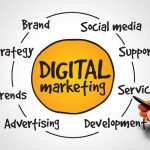If you’re aren’t one yourself, you could quite justifiably be confused about what a marketer does.
Looking in from the outside, people tend to have lots of misconceptions about what marketers really do:
-
- They’re just cold-callers or door-to-door salespersons
- Marketers are always in confrontation with sales departments
- It’s the job of a marketer to push purchasing decisions on to people
- Marketing is the same as advertising
- Marketing is the job of only the marketing department and marketers
- It’s impossible to measure the effects of marketing efforts
These are just some of the myths that prevail around the process of marketing, even though it has been a subject of academic study for more than four decades.
In fact, marketing touches every aspect of your business, right from the factory floor to doorstep delivery.
With new concepts such as relationship marketing emerging, it’s important to dig deeper into the concept itself.

What Marketers Really Do
They are the folks who inform and educate about their products and services, and persuade you to purchase. But they also use various strategies to help businesses to sustain, grow, make profits, stay ahead of competition and build a strong organization for the long term.
They may direct marketing efforts towards customers (B2C) and/or towards other businesses (B2B).
Today, marketing has moved beyond the traditional focus on sales and revenues, organizational focus, product focus and promotion, to a customer-centric activity that places the relationship between all the parties involved as the main priority.
Depending on which marketing guru you read, you would find descriptions of anything from eight to forty different types of marketing.
Most organizations follow a convenient mix of many of these types, based on the nature of their product/services, extent of operations, customer profile, age of the organization, or financial status, geography and values. These various marketing orientations help marketers to plan their strategy.
Advances in technology and the advent of the internet have dramatically altered the marketing landscape.
Traditional, outbound/inbound, digital, SEO, content marketing, social media marketing, video/audio, email, word-of-mouth, referral, direct, social influencer, contextual, acquisition, brand, relationship, personalized, and more are part of the suite of strategies that marketers can incorporate.
What Is Relationship Marketing?
Organizations that focus on creating continuous value for their customers stay ahead in the competitive race.
Studies show that it is five times more expensive to acquire a new customer compared to retaining an existing one.
Though this principle has been known for a very long time, in reality, only 18% of companies focus on customer retention compared to 44% who focus on new acquisitions. And less than half the companies surveyed are able to correctly measure customer lifetime value.
When a new prospect enters your website (or store) there’s only a 20-30% chance of their purchasing, while there is a 60-70% chance of selling to a loyal customer.
Existing customers are more inclined to provide genuine feedback, try new products/services, and spend more money, have more trust in recommendations and willing to engage in dialogue.
Additionally, as most marketers well know, 20% of existing customers are responsible for 80% of revenues.
Keeping these factors in mind, the concept of relationship marketing begins to become more clear.
Just as a long-term relationship is more beneficial to the parties involved, this marketing approach uses the same principle in marketing as well.
Long term relationships are characterized by commitment, loyalty, meaningful engagement, trust and openness.
Relationships are less transactional and there is no hidden agenda.
Similarly, relationship marketing focuses on creating, building, nurturing and sustaining long term relationships instead of focusing merely on immediate sales and revenues.
Loyal customers can also be transformed into marketing evangelists for your products and services. They share their experiences with their circle of friends, family and co-workers, and also on social media, giving a wider, more organic and natural boost to your marketing strategy.
Relationship marketing can be divided into segments such as:
-
- Affiliate
- Partner
- Influencer
- Referral
- Employee Advocacy
How Is Relationship Marketing Important for Marketers?
The power and reach of the internet have transformed the way businesses operate. Today, economies have opened up, and competition is no longer restricted to your own neighborhood or even your own country. Globalization, economic liberalization, technical advancement and customer exposure to hitherto unknown products/services have tellingly revolutionized how businesses approach marketing.
The new model is based on knowledge and information about the customer as a unique individual and not just a part of an amorphous, anonymous group.
The recent decades have shown us how vulnerable markets are to fluctuations in distant shores. To stay afloat, grow and expand, a business has to adopt larger investments in technology, and ensure that they’re more strongly connected to their customers.
Businesses have become more diverse, with multi-offerings, multi-products and multi-service orientation. With access to more data than has ever been possible in the history of commerce, businesses are poised to make the next great leap.
This makes it even more important to create and sustain a client pool that can find everything they need under a single brand.
Deploying relationship marketing strategies means:
-
- Higher investment in technology rather than focusing on the sales bottom-line
- Reduced administrative/marketing costs on new customer acquisition
- More emphasis on personalized email marketing and loyalty points
- Better employee retention in your company
- Creating a consistent and regular revenue flow
- Building and maintaining an excellent website
- Offering on-line chats, virtual assistants, toll-free phone
- Focus on social media channels
- Meeting your customers where they spend most of their time online
- Referrals and personalized campaigns
- Introducing more helpfulness, caring, and two way connections over just promotion
- Seeing the trade as a managed relationship where customers create their own value
- Using a range of overlapping strategies to nurture deeper relationships
- Managing the customer experience
- Improving the customer journey
- Generating leads and managing customer data
- Accurate measurement of customer satisfaction and tracking of behavior
- Predicting future customer behavior, and using this data to drive expansion and growth of the company
Though adopting relationship marketing strategies takes more time and effort if your company has been practicing traditional marketing, the ROI is significant and supportive of long term growth and expansion.
It’s important to convey the relationship message to your entire organization and get a buy-in across the company for relationship marketing to work.











